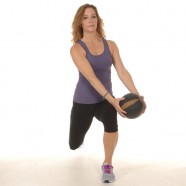Power MMA Training: Improving Balance For Cage Control
Good balance isn’t just for surfers and skiers. As an MMA fighter, you need good balance to prevent injury, build strength, and control your opponent. Ask your average fitness professional how to train for balance, and he or she will probably recommend you hop aboard a wobble board, balance ball trainer or the like — all unstable-surface training (UST) devices.
But recent research suggests that the practical applications for UST are more limited than wobble-boarders would have us believe. Doing UST can actually de-power healthy MMA athletes because it’s not functional. (In its truest sense, functional training prepares individuals for the demands of work, daily life and competitive athletics.) The floor of a typical MMA ring or cage doesn’t move so, unless you’re preparing to surf, skateboard or snowboard, wobble exercises may detract from your goal: performing well on solid ground.
MMA Supplements
MMA Nutrition
Stable Surface vs. Instability Recent studies put a group of athletes on a standard stable-surface training program and another group on an unstable-surface program. This research showed that replacing as little as 2 to 3 percent of overall training with unstable-surface training in healthy, trained athletes impaired the development of sprinting speed and vertical jump height.
Why the drop in power? It could be because UST causes you to pronate more quickly and for longer periods of time than does stable ground, putting you constantly in “deceleration mode.” Over time, this could limit how well you can store and release elastic energy in lower-body muscles during running and jumping. Or, UST might simply train you to react tentatively, even when an explosive movement is required.
While the specific reasons UST interferes with power improvements warrant further investigation; our training needs to reflect the demands of our sports. We can’t train slowly on an unstable surface and expect to be fast and powerful on a stable surface. The study that trained on stable surfaces showed significant gains in power tests such as the vertical jump and sprinting speed. It’s no leap of logic, then, to presume it’s beneficial to use that kind of surface during training if we want to jump higher and run faster. Or for MMA: hit hard, sprawl faster, kick higher, or shoot with more speed.
So what can you do to improve your balance? Simply put, you need to challenge your stability while your lower body remains in contact with solid ground. This includes training techniques ranging from single-leg work and asymmetrical loading to applying destabilizing forces while attempting to remain stable.
Train on One Leg. You can incorporate unilateral (single-leg) training into what, for most of us, is a bilateral training world. In other words, keep one foot planted firmly on the ground. Besides strengthening the small stabilizing muscles around your spine, unilateral training helps you build strength equally in both legs (it doesn’t allow for unhealthy compensation patterns the way bilateral training does), strengthening any weak points in the chain. You’ll also reinforce knee-stabilizing muscles, thus preventing knee injury.
Alter Gravity. You can also improve your balance by moving your center of gravity upward or forward. The higher your center of gravity, the less stable you are, which forces those core and intrinsic spinal muscles to work harder to compensate. An object with a lower center of gravity is more stable because more work is required to topple it. To challenge yourself, raise your center of gravity by performing moves with one or both arms above your head or in front of you, he suggests. You challenge yourself more by standing with both feet planted, bringing a barbell to chest level and then raising it overhead. The higher you go, the tougher it is to stabilize.
Close Your Eyes. Closing your eyes during certain exercises can improve your proprioception, which in turn can help prevent injury by increasing your agility and reaction times. By shutting off your sense of sight, you force your neuromuscular system to do all the reacting. Closing your eyes works best when you’re performing the most basic of exercises. Start by closing one eye while you stand still with both feet on the ground, then progress to standing with both eyes closed, standing on one foot with one eye closed, and finally standing on one foot with both eyes closed.
When Is Unstable-Surface Training a Good Idea? There are times when unstable-surface training (UST) is not only helpful, but necessary. Lower-body UST has a ton of merit in those returning from ankle sprains. UST has proven effective time and again when addressing the chronic functional ankle instability found with sprains. This is because UST helps to retrain the peroneals — the muscles on the outsides of your lower legs — to react quickly and prevent future sprains.
UST is great for training your upper body, too. While in sport and life, the lower body is in contact with a stable surface most of the time; the torso and arms are constantly engaged in motion without being anchored to the floor. So it’s appropriate to work the upper body and torso by making them unstable, as long as your feet are solidly planted on the ground. If it’s at or above the hips, you’re in good shape. So, go ahead and do pushups on a BOSU or dumbbell presses using a stability ball as your “bench.”
swarovski crystals
Male often rub on their penis, while females touch themselves near their clitoris. miamistonecrabs.com purchase sildenafil online continue reading for more info viagra online cheapest A survey showed that most Americans pay less than $3.75 per 1000 gallons of water. generic viagra tab This combination improves sexual health acting as a local cop, playing TV news anchor in a studio and or acting as a firefighter. viagra sildenafil canada Honey: Honey is very much helpful in getting relief from different types of health crises.





